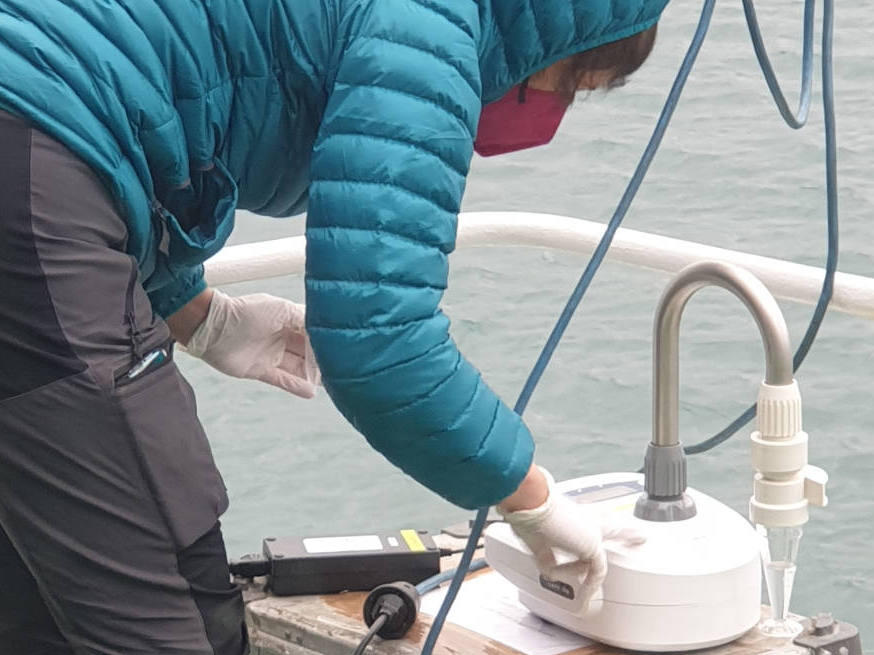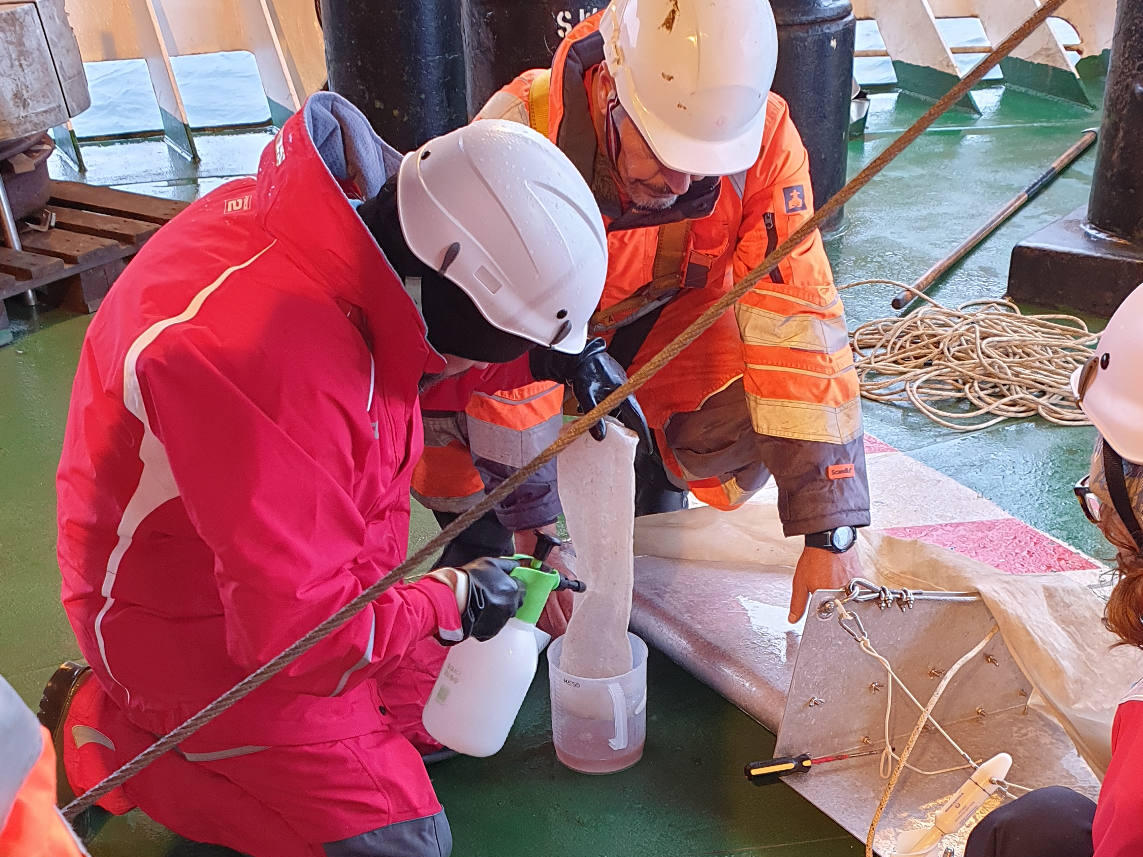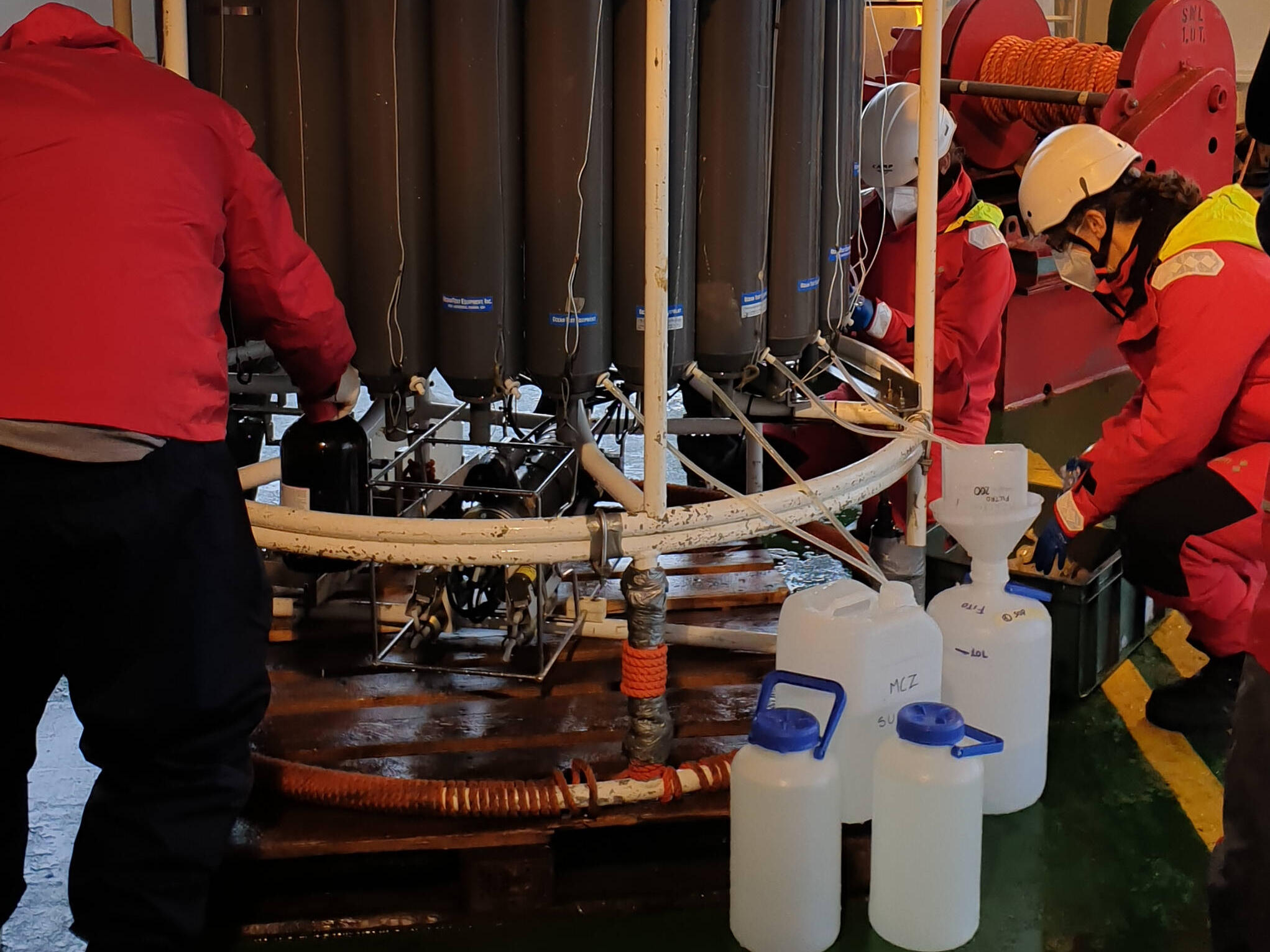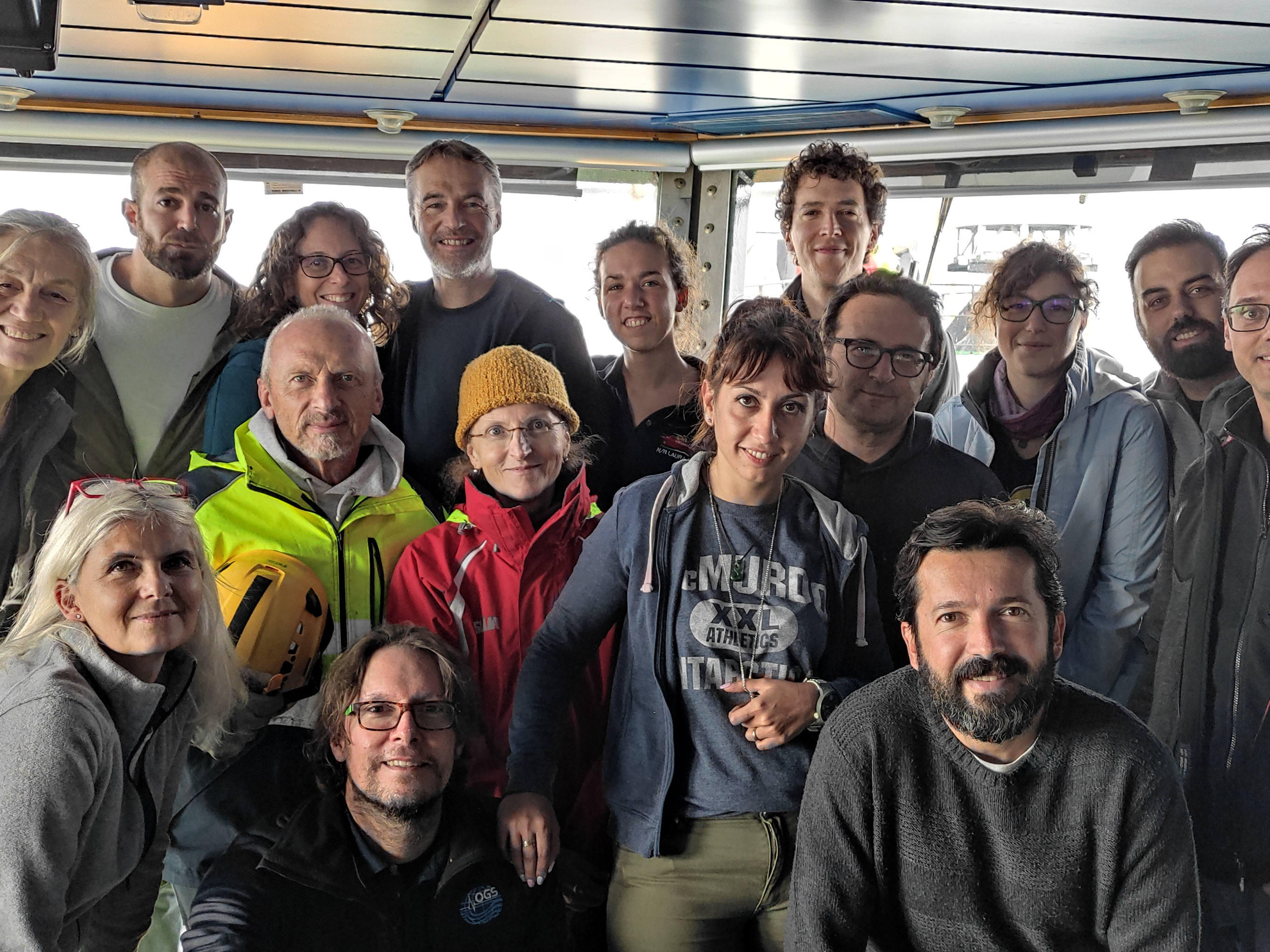- Acronimo
- CASSANDRA
- Area di ricerca
- Life science
- Tematica specifica di ricerca
- Physical, chemical, biogeochemical and biological oceanography
- Regione di interesse
- Greenland Sea Gyre
- PI
- Maurizio Azzaro
- Istituzione PI
- Institute of Polar Sciences - National Research Council
- Sito web istituzionale
- https://www.isp.cnr.it
- Altre Istituzioni e soggetti coinvolti
- National Institute of Oceanography and Applied Geophysics
- Consistenza del team ricerca
- Sixteen researchers (nine men and seven women) participated in the oceanographic cruise, six of whom were early-career scientists. A total of 25 researchers (17 women and eight men) participated in the study.
- Stato progetto
- Completato
- Il progetto
- Immagini
-
- Motivazione, importanza della ricerca
The Arctic and sub-Arctic regions have been warming more than twice as rapidly as the rest of the world for the past 50 years. The Arctic climate has undergone tremendous changes, such as Arctic wetting, reduction of Arctic sea ice thickness and coverage, decrease of snow cover extent and duration, thawing of permafrost and melting of Greenland ice sheet. The Greenland Sea is one of the key regions of deep ocean convection (12,13), an important process for carbon sequestration and global ocean ventilation, and its dense waters feed the lower limb of the Atlantic Meridional Overturning Circulation (AMOC). It is not really well known how much the Greenland Sea contributes to AMOC and thus its sensitivity to climate change, but the variability of its contribution strongly depends on the physical drivers that trigger the convective activity in the Greenland Sea Gyre . Moreover, the Greenland Sea is a crossroads where inputs and exchanges of heat, salts, nutrients, carbon and organisms between the Arctic, sub-Arctic and lower latitudes occur. In light of its importance, many multidisciplinary studies have been carried out in this sub-Arctic region, but climate changes are rapidly creating new conditions that may affect marine biogeochemistry and the marine food webs. Providing the knowledge on how the Arctic system functions assess risks and develop policies that allow effective management is the utmost motivation of the international Synoptic Arctic Survey (SAS; https://synopticarcticsurvey.w.uib.no). SAS is a bottom-up, researcher-driven initiative that seeks to quantify the present state of the Arctic Ocean and understand the major ongoing transformations, with an emphasis on water masses, the marine ecosystems, and the carbon cycle. As of now, SAS consists of regional shelf-to-basin ship-based coordinated surveys (2020-22) to generate a comprehensive dataset of essential ocean variables (atmospheric, chemical-physical, biogeochemical and biological) on a quasi-synoptic, spatially distributed basis. CASSANDRA aimed to contribute to the SAS effort by studying in the summer 2021 a historical transect to 75°N crossing the GSG, and providing a temporal integration for a complete characterization of the Pan-Arctic hydrography and circulation, ocean acidification, and biological and ecosystem functioning and productivity.
- Obiettivi della proposta
CASSANDRA overarching goal is to contribute to the evaluation of the current state and major ongoing transformations of the Arctic marine system along one of the main gates to the Arctic Ocean. To achieve this scope CASSANDRA will pursue 3 key foci: A) Physical and biogeochemical state and variability; B) Microbial Ecosystem response C) Carbon cycle and Ocean Acidification. The aims of the focal areas are: A1) Depict the distribution and the dynamics of the main water masses in the area of the GSG, and investigate the effects of processes that determine, at different spatial and temporal scales, atmospheric and oceanic circulation patterns; A2)Characterize the water masses biogeochemistry; B1) Evaluate the plankton diversity, abundances, and population structures living in the GSG and the northward range expansion of non-indigenous species; B2) Quantify how primary production varies in relation to the nutrients availability and its degree of coupling/decoupling with other activities; B3)Estimate the biomass flux in the analyzed ecosystems; C1) Determine the exchanges inorganic carbon along the 75°N transect; C2) Quantify the input and fate of organic carbon; C3) Assess the levels of acidification and possible impacts on the marine biota.
CASSANDRA will train young researchers and create opportunities to promote the next generation of polar researchers. Knowledge of how the Arctic system works will allow risk assessment and development of policies enabling effective management.
- Attività svolta e risultati raggiunti
In September 2021, as part of the Italian Arctic research programme, a multidisciplinary cruise along the 75th parallel north through the Greenland Sea Gyre was conducted aboard the Italian icebreaker Laura Bassi in the framework of the CASSANDRA project, which also contributed to the Synoptic Arctic Survey (SAS) 2020/22. The cruise took place during the period of the lowest summer sea ice extent ever measured. The data showstrong horizontal gradients with temperatures between 1.5 and 9.0°C and salinity between 30 and 35. Warm and salty Atlantic Water (AW, >3.0°C, S around 35) dominates on the eastern side of the transect in the upper 500m with surface temperatures of 4.5–9.0°C, while Polar Water (PW, <0°C, S <33) occupies the surface layer (50–80m) in the west. The intermediate layer (100–500m) consists of mixed water, and below 500m the deep water of the Greenland Sea and the Norwegian Sea predominates. The oxygen enrichment is higher in the intermediate layers, while the values in deep layers and western regions are lower (< 300µmolkg 1). A stratified upper layer (30–50m deep) with low surface nutrients, especially nitrate, is observed, while an accumulation of silicate occurs in deep water masses. The surface water in the eastern part of the transect has high pHT and total alkalinity values due to photosynthesis and the presence of salty AW, while the fresh PW in the west has a lower alkalinity. Respiratory activity and organic matter concentrations (particulate/dissolved organic carbon) vary horizontally at the surface, decrease with depth, and increase slightly near the seafloor. A west–east gradient is also observed for 18O and D, with the ratios indicating the influence of freshwater at the surface near the Greenland coast. The abundance of prokaryotes decreases from the photic zone (< 100m depth) to the sea floor. Carbohydrates and carboxylic acids are identified as well-utilised polymers at every station and in every layer. Overall, the microbial enzyme patterns show a decrease from the surface to deeper layers, with some hotspots of metabolic activity at 20–40m and in the aphotic layer. The enzyme patterns vary spatially, with activity peaks at the ends and in the middle of the transect. Phytoplankton biomass, expressed as chlorophyll a, varies across the transect, with higher values at the westernmost and easternmost stations. The micro-phytoplankton fraction dominates in PW, while the nano-phytoplankton fraction predominates in AW, even at the interface between the two water masses. Data of phytoplankton communities show low abundances and a dominance of nano-sized organisms, with diatoms being more abundant in the western part. Microzooplankton represents an important fraction of the planktonic community in this area, with tintinnids being the most important groups along the transect. Micrometazoans and aloricate ciliates are more abundant in the AW, resulting in higher biomass values at the eastern stations. Copepods are the most abundant mesozooplanktonic taxon both at the surface and in the upper 100m water layer (97% and 94% of total mesozooplankton abundance, respectively), mainly represented by the genus Calanus. The data are publicly available at the Italian Arctic Data Centre (IADC), see https://doi.org/10.71761/ c082c3ca-40bf-42b1-a61a-7b3697ab2c5a (Bensi et al., 2024), https://doi.org/10.71761/f7474404-3331-43e5 883b-25755e94956d (Azzaro et al., 2024).
- Prodotti
- Azzaro M., Rizzo C., Maimone G., Papale M., Rappazzo A.C., Lo Giudice A., Cosenza A., Feltracco M., Petricciuolo M., Federici E., Vitale V. (2024) First observations on airborne prokaryotes in a subArctic Atlantic marine area. Polar Science, DOI: 10.1016/j.polar.2024.101104.
- Bensi M., Civitarese G., Borme D., Caroppo C., Caruso G., Cerino F., Decembrini F., de Olazabal A., Diociaiuti T., Giani M., Kovacevic V., Kralj M., Lo Giudice A., Maimone G., Monti M., Papale M., Patrolecco L., Putelli E., Rappazzo A.C., Relitti F., Rizzo C., Spataro F., Tirelli V., Turetta C., Azzaro M. (2025) The Italian contribution to the Synoptic Arctic Survey programme: the 2021 CASSANDRA cruise (LB21) through the Greenland Sea Gyre along the 75°N transect. Earth Syst. Sci. Data, doi.org/10.5194/essd-17-3701-2025.
- Caruso G., Maimone G., Rappazzo A.C., Papale M., Rizzo C., Cosenza A., Lo Giudice A., Azzaro M. (2025) First study on microbial community-level physiological profiles across a subArctic Atlantic marine transect. Polar Biology, DOI: 10.1007/s00300-025-03416-3.
- Maimone G., Lo Giudice A., Papale M., Rappazzo A.C., Rizzo C., Cosenza A.,Paranhos R., de Souza C.A., Relitti F., Kralj M., Azzaro M. (2025) Morphological traits of prokaryoplankton across an Atlantic subarctic marine transect. Polaqr Biology, 10.1007/s00300-025-03404-7.
- Caruso G., Rappazzo A.C., Papale M., Azzaro M. (2025) Culturable Plastisphere from the 75° N Subarctic Transect as a Potential Vector of Pathogens and Antibiotic-Resistant Bacteria.Journal of Marine Science and Engineering, DOI: 10.3390/jmse13030448.
- Munteanu A., Bortolini M., Feltracco M., Alteria A., Cairns W.R.L., Turetta C., Barbaro E., Barbante C., Gambaro A., Azzaro M. (2025) Contamination by benzothiazoles in the Arctic: First evidence in the seawater of the Greenland Sea. Environmental Pollution, DOI: 10.1016/j.envpol.2025.125943.
Rappazzo A.C., Caruso G., Cosenza A., Lo Giudice A., Maimone G., Papale M., Bensi M., Kovacevic V., Azzaro M. (2025) Prokaryotic viability and active metabolism across a Greenland Sea transect (75°N latitude). AIMS Microbiology, in press.
Data Set
Azzaro M., Bensi M., Civitarese G., Giani M., Monti M., Diociaiuti T., Relitti F., Kralj M., Tirelli V., Borme D., Goruppi A., Putelli E., de Olazabal A., Ogrinc N., Cerino F., Rappazzo A. C., Papale M., Turetta C., Decembrini F., Caroppo C., Maimone G., Patrolecco L., Spataro F., Rizzo C., Caruso G. (2024) CTD (data from NISKIN Bottles) LB21 ARCTIC Cruise Italian Arctic project CASSANDRA, ISP-CNR [data set], https://doi.org/10.71761/f7474404-3331-43e5-883b 25755e94956d, 2024.
Bensi, M., Kovacevic, V., and Mansutti, P.: CTD (DOWNCAST) LB21 ARCTIC Cruise Italian Arctic project CASSANDRA, IADC [data set], https://doi.org/10.71761/c082c3ca-40bf-42b1 a61a-7b3697ab2c5a, 2024.



